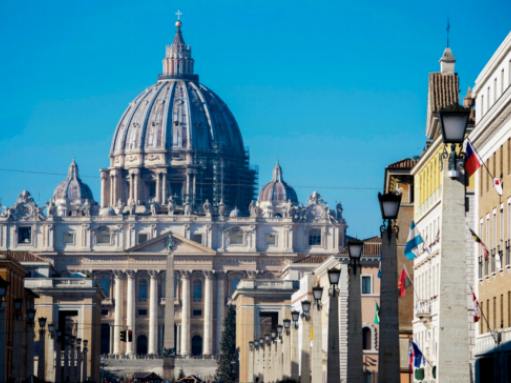Nestled beneath the grandeur of St. Peter's Basilica in Vatican City lies a hidden world filled with historical treasures, artistic wonders, and spiritual significance. The Vatican Grottos and Tomb of St. Peter offer visitors a unique glimpse into the rich history and religious significance of one of Christianity's holiest sites. Join us on a journey of exploration as we uncover the secrets and beauty that lie beneath the surface of this sacred place.

Exploring the Tomb of St. Peter in Vatican City
The Vatican Grottos, located beneath St. Peter's Basilica in Vatican City, hold a special place of significance for Christian pilgrims and tourists alike. One of the main attractions within the grottos is the tomb of St. Peter, considered by many to be the final resting place of one of Jesus' twelve apostles.
Visitors to the Vatican Grottos can explore the tomb of St. Peter, which is believed to have been located in this spot since the early days of Christianity. The tomb itself is a site of reverence and devotion for millions of Catholics and other Christians who come to pay their respects to the man they consider to be the first pope.
The tomb of St. Peter is located directly beneath the main altar of St. Peter's Basilica, providing a direct connection between the physical church above and the spiritual significance of the apostle's burial place below. The grottos create a sense of awe and wonder for visitors, offering a glimpse into the rich history and tradition of the Catholic Church.
Exploring the tomb of St. Peter in the Vatican Grottos is a truly unique and spiritual experience for those who visit, allowing them to connect with the roots of their faith and the legacy of one of Christianity's most important figures.
Artistic Features Found in the Vatican Grottos
The Vatican Grottos are known for their stunning artistic features. As visitors descend into the underground caves beneath St. Peter's Basilica, they are greeted by beautiful works of art that have been carefully preserved for centuries. From intricate mosaics to ornate sculptures, the grottos are a treasure trove of artistic masterpieces that offer a glimpse into the rich history and culture of the Vatican City. Each piece tells a story and adds to the overall ambiance of this sacred place. Art lovers and history enthusiasts alike will marvel at the craftsmanship and beauty of the artistic features found in the Vatican Grottos.
Archaeological Discoveries Beneath St. Peter's Basilica
Beneath the majestic St. Peter's Basilica in Vatican City lies a treasure trove of archaeological discoveries. Excavations beneath the basilica have revealed a complex network of ancient Roman tombs and pagan temples that predate the construction of the basilica itself. These discoveries provide a fascinating glimpse into the history of this sacred site and shed light on the religious practices of the early Christians who revered St. Peter as their first pope.
One of the most significant finds beneath St. Peter's Basilica is the necropolis, or city of the dead, that dates back to the first century AD. This necropolis is believed to be the final resting place of St. Peter himself, as well as other early Christian martyrs. The tomb of St. Peter was discovered in the mid-20th century and confirmed by archaeological experts, confirming the longstanding tradition that St. Peter's remains were buried beneath the basilica.
In addition to the necropolis, archaeologists have uncovered remnants of ancient pagan temples and Roman structures that once stood on the site where St. Peter's Basilica now stands. These discoveries provide valuable insights into the religious practices of the ancient Romans and the ways in which Christianity coexisted and eventually triumphed over pagan beliefs in the early centuries of the church.
The archaeological discoveries beneath St. Peter's Basilica offer a unique opportunity to explore the history of one of the holiest sites in Christianity. By delving into the ancient past of the Vatican Grottos and the tomb of St. Peter, visitors can gain a deeper appreciation for the spiritual significance of this sacred place and the enduring legacy of St. Peter as the first pope of the Catholic Church.
Spiritual and Religious Practices at the Tomb of St. Peter
The Tomb of St. Peter in Vatican City holds immense spiritual and religious significance for Catholics around the world. Pilgrims from all corners of the globe come to pay their respects to the first Pope and one of the twelve apostles of Jesus Christ.
Visitors to the tomb often engage in acts of devotion such as prayer, lighting candles, and leaving offerings. Many believers kneel in front of the tomb, deep in contemplation and meditation. Some may touch the tomb or kiss it as a sign of reverence and faith.
The atmosphere around the tomb is often filled with a sense of sacredness and solemnity. The faithful believe that the tomb is a place where they can connect with St. Peter's spirit and seek his intercession in their prayers and supplications.
Masses and religious services are also held at the tomb, allowing worshippers to participate in the rich tradition and history of the Catholic faith. The presence of the tomb serves as a reminder of the enduring legacy of St. Peter and his role in the establishment of the Christian church.
Overall, the spiritual and religious practices at the Tomb of St. Peter serve as a powerful symbol of faith and devotion for Catholics worldwide. It is a place where believers can deepen their connection to their religious beliefs and find solace in the teachings and guidance of St. Peter.
